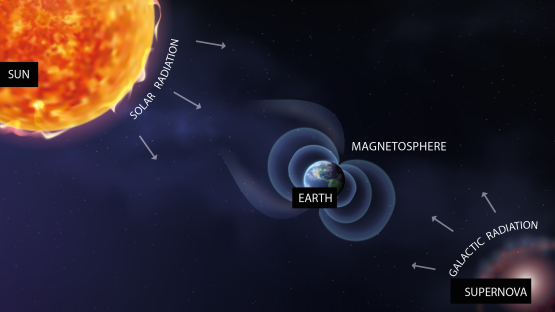Cosmic radiation is what it sounds like: radiation from space. In this article, we explore what it is, why we are protected from it on Earth, how it affects people in specific jobs, and how it can even help advance technology for cancer treatment.
What are cosmic rays?
Cosmic rays are extremely high-energy subatomic particles – mostly protons and atomic nuclei accompanied by electromagnetic emissions – that move through space, eventually bombarding the Earth’s surface. They travel at nearly the speed of light, which is approximately 300 000 kilometres per second.
Where do they come from?
Cosmic rays are of two kinds: galactic and solar. Galactic cosmic radiation comes from the remnants of supernovas, which are powerful explosions during the last stages of massive stars that either collapse to black holes or are destroyed. The energy released in these explosions accelerates charged particles outside our solar system, making them highly penetrating and extremely hard to shield. In essence, supernovas act like huge, natural particle accelerators. The Earth is constantly exposed to galactic cosmic radiation.
Solar cosmic radiation is composed of charged particles emitted by the Sun, predominantly electrons, protons and helium nuclei. Some of this radiation is continuously emitted from the Sun’s corona, which led scientists to call it the ‘solar wind’. The remainder comes from solar particle events – sudden and sporadic outbursts of electrically charged particles accompanied by electromagnetic emissions that occur when magnetic fields on the Sun’s surface stretch and twist. Like a rubber band, the Sun’s fields can snap, suddenly releasing enormous energy and presenting potential health concerns to astronauts in space. Although rare, strong solar flares can eventually create radio blackouts and impact modern communication and navigation technology on ground.
Are cosmic rays reaching us on ground?
The Earth is shielded by a magnetic field that makes the charged particles bounce from pole to pole, creating two gigantic donut-shaped belts populated by energetic electrons and protons. The magnetosphere deflects cosmic rays and protects us from solar flares. Sometimes, cosmic radiation does reach us, but without creating any harm, just like other low levels of radiation we are regularly exposed to. On average, people are exposed to around 3.5 millisieverts of radiation per year. About half of this comes from artificial sources such as X-ray, mammography and CT scans, while the other half we get from natural sources, of which about 10 per cent comes from cosmic radiation. Sievert is the measure of health risk from radiation: one sievert carries with it a 5.5 per cent chance of eventually developing radiation-induced cancer later in life.
“Cosmic-ray particles sneaking into the atmosphere at the Earth’s magnetic poles can create truly astonishing, colourful auroral lights,” said Michael Hajek, External Dosimetry Specialist at the IAEA. Joan Feynman, an astrophysicist who dedicated most of her life to studying auroral lights, found out that these magical phenomena predominantly seen at high latitudes around the Arctic and Antarctic are the result of collisions between charged particles of the solar wind and the gaseous constituents of the atmosphere. The most common auroral colour, a pale yellowish-green, is produced by oxygen molecules, while nitrogen gives rise to blue or purplish-red aurora.
Do they reach us when we fly?
Yes. While airplanes passengers are exposed to elevated levels of cosmic radiation, especially at higher altitudes and latitudes, the radiation they receive in one flight is quite insignificant. Aircrew and frequent flyers are exposed to higher levels of radiation doses from space, because of how often they fly. The crew on flights typically operating at low altitude, such as most propellant aircraft, will hardly exceed a dose of one millisievert per year. Crew serving on long-haul polar routes, though, might be exposed to an annual effective dose of up to six millisieverts.
“In its safety standards, the IAEA has a dedicated section, GSR-Part 3, section 5, that outlines what options Member States have to reduce aircrew radiation exposure,” said Tony Colgan, Head of the IAEA’s Radiation Protection Unit. Flying hours for aircrew are controlled by the International Air Transport Association (IATA), which also places limits on the radiation doses they can be exposed to.
What about astronauts?
Space crew receive an even higher radiation dose. An astronaut on board a space station orbiting the Earth at an altitude of 400 kilometres is typically exposed to a dose of more than half a millisievert per day. In 12 days, they would get the same dose as aircrew gets in a year. National space agencies have established career dose limits for astronauts. Health effects such as radiation carcinogenesis and certain tissue reactions could have been linked to cosmic radiation exposure in astronauts, although the small sample size makes it difficult to quantify these effects.
Can we benefit from cosmic radiation on Earth?
“It is fascinating how our understanding of cellular damage induced by high levels of cosmic radiation could help advance technology for cancer treatment using high-energy particle accelerators,” Hajek said. Because of their unique properties, beams of charged particles, similar to those encountered in space, can destroy deep-seated tumours while minimizing damage to surrounding tissues. “Insights from ion therapy, in turn, will enable us to improve radiation protection in space and overcome the current limitations in predicting health risks for long-duration space travel,” Hajek explained.




